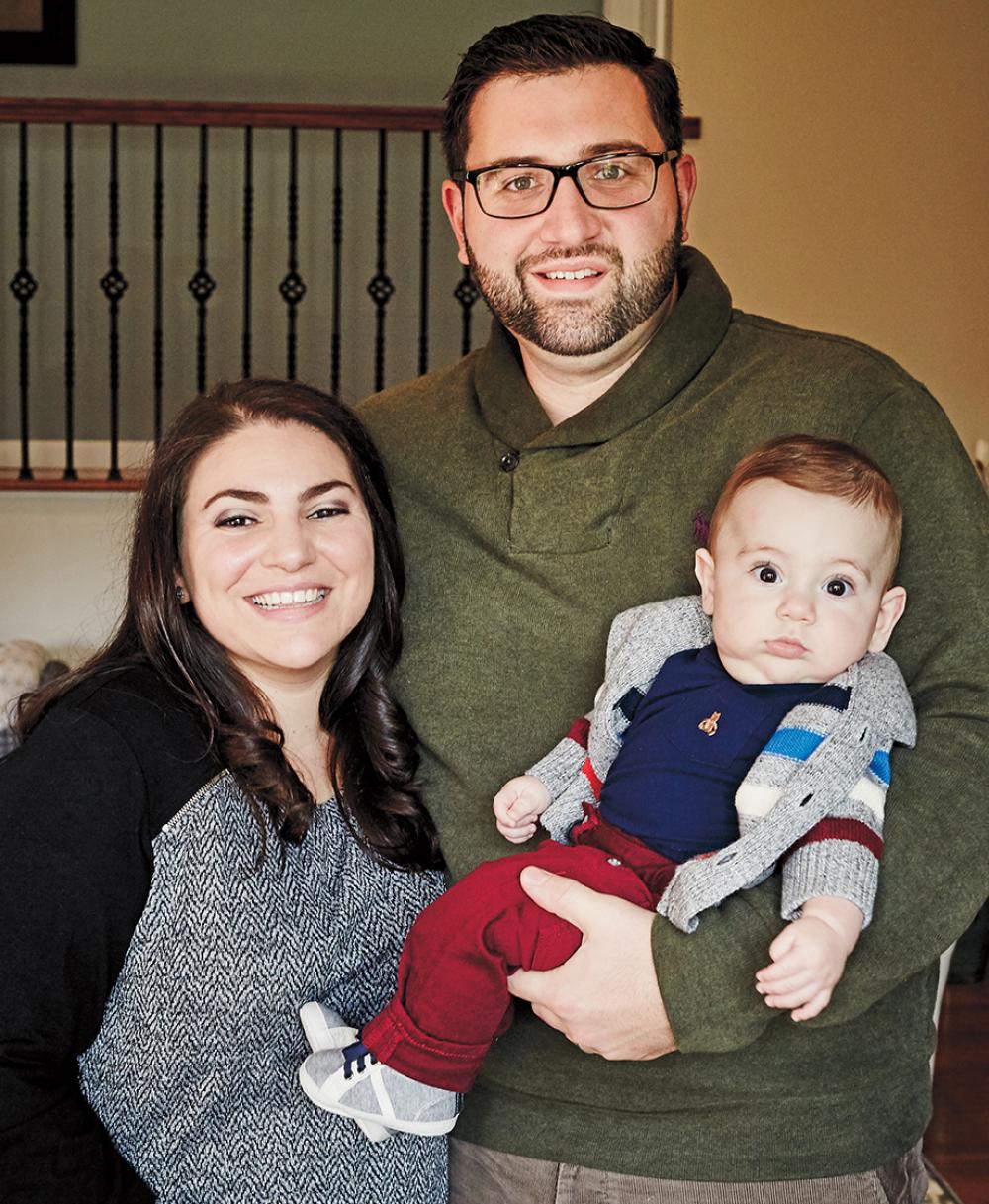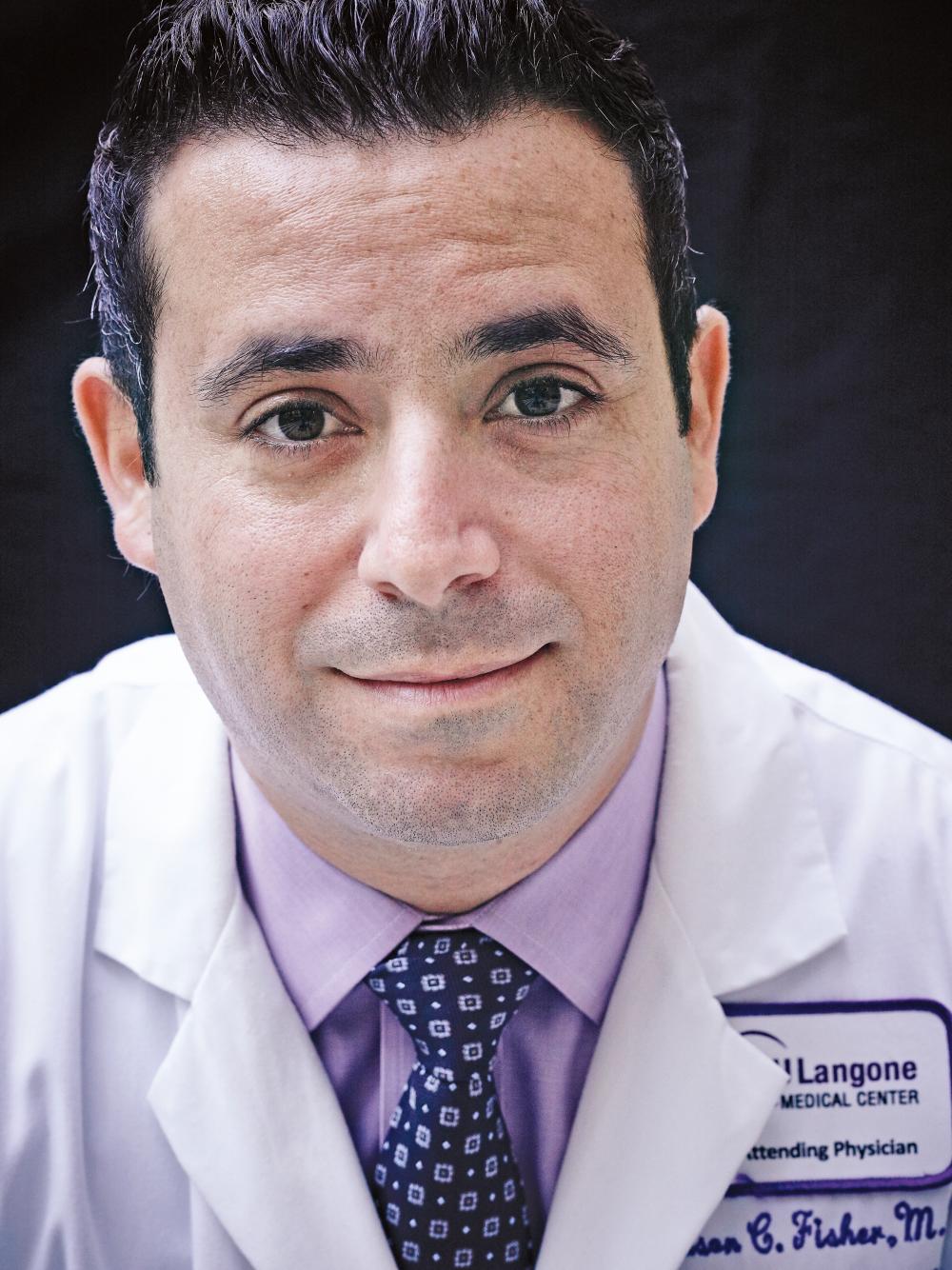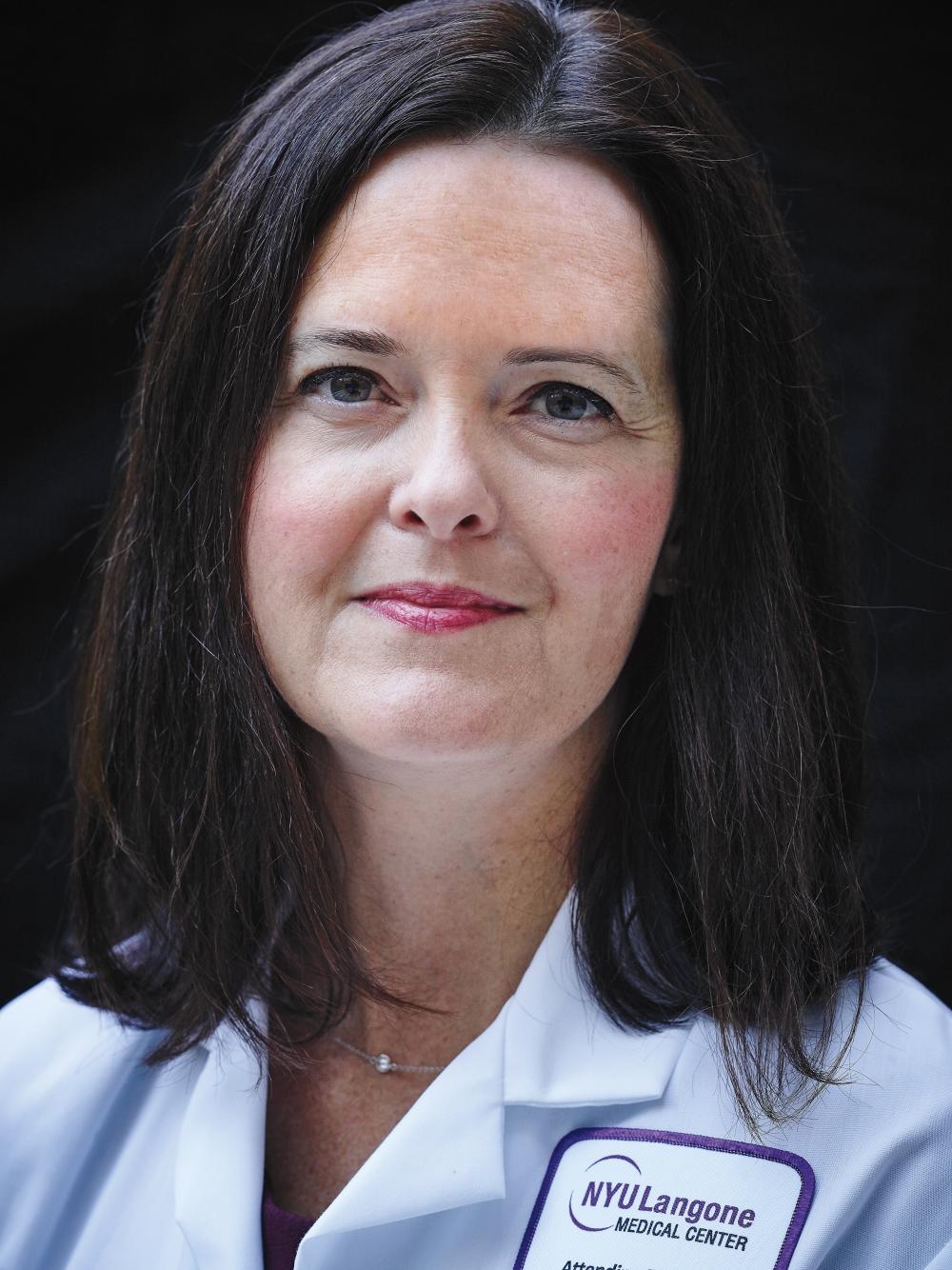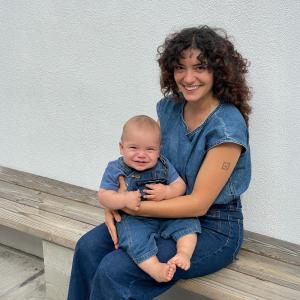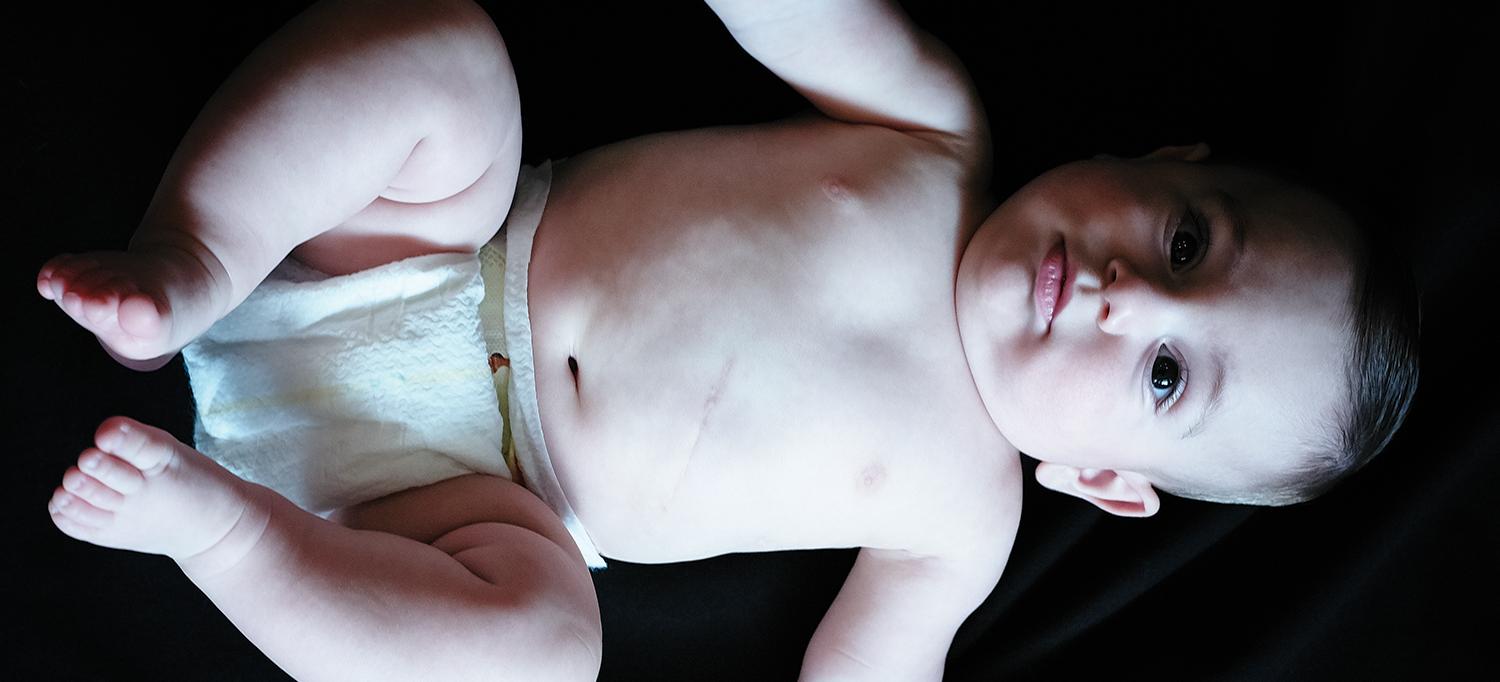
Joey Doell, born with a congenital diaphragmatic hernia, approximately six months after undergoing complex surgery at NYU Langone.
Photo: Walter Smith
Just when her last two months of pregnancy seemed like a final lap, 29-year-old Jaclyn Doell’s water broke. At first, it was just a few drops during breakfast with husband, Nick, her college sweetheart, in their home in Little Falls, New Jersey. Then came the deluge at a staff meeting at a nearby community hospital, where Doell works as a pediatric intensive care nurse. Alarmed but calm, she went upstairs to see her obstetrician—and suddenly a routine pregnancy became a crisis.
An ultrasound showed the baby’s heart pushed too far to the right. Then, an MRI confirmed a rare, devastating birth defect: a congenital diaphragmatic hernia (CDH), in which the stomach, intestines, spleen, and other organs squeeze through a breach in the diaphragm, crushing into the chest cavity where the lungs would normally develop. Of the estimated 1,600 babies diagnosed with this condition each year in the U.S., nearly half do not survive. For the Doells’ baby boy, the prognosis was considerably worse. He was given a 33 percent chance of survival, and he would almost certainly require a heart-lung bypass machine at birth. “I work with critically ill children,” says Jaclyn. “I’ve seen a lot. But being on the other side was a complete shock.”
Since the hospital wasn’t equipped to care for such a critically ill newborn, Jaclyn was transferred to NYU Langone Medical Center, where she was admitted to the new Fetal Diagnosis and Treatment Program, a tightly knit team of some 50 obstetric and pediatric specialists who handle the most precarious high-risk pregnancies and life-threatening congenital defects. She was put on bed rest at Tisch Hospital under the watch of Ashley Roman, MD, clinical assistant professor of obstetrics and gynecology, and director of the Division of Maternal Fetal Medicine.
Nationwide, one in 33 newborns suffer from a birth defect. Of the 6,200 babies delivered at NYU Langone last year, about 200 fell under the care of the Fetal Diagnosis and Treatment Program. Two-thirds of the cases had critical congenital heart defects requiring surgery within six months of birth. Others had lung or chest masses, obstructed or perforated bowels, oral-facial clefts, or congenital diaphragmatic hernias, like baby Doell. There were more than a dozen cases of distressed twin or triplet pregnancies. Left untreated, many of these conditions would have proved fatal.
Overall, the program can handle about 95 percent of all fetal abnormalities and maternal complications, according to Dr. Roman. Such exceedingly complex pregnancies require a high level of collaboration, so the program taps into more than a dozen different specialties, including ones in maternal-fetal medicine, neonatology, pediatric surgery, pediatric cardiology, pediatric neurosurgery, genetics, and social work. Team members assemble twice each month, under the direction of Dr. Roman, to discuss cases and devise treatment strategies. Every detail is worked out in advance: What is the optimal time for birth, allowing the best possible outcome? Does the baby need surgery within minutes or days after delivery? Who needs to be present? Is prenatal surgery feasible or beneficial?
“This is not something that is done at all hospitals,” explains Dr. Roman. “This program exists because studies show that when you get everyone in a room together and come up with a plan as a team, patients get better care.”
Jason Fisher, MD, had a plan. If Jaclyn could make it one more month, to 36 weeks, the baby’s lungs would theoretically be strong enough to maximize his chances for survival. “The goal was to reposition the baby’s organs and patch the hernia within the first few days after birth, as long as the heart and lungs were strong enough to withstand surgery,” says Dr. Fisher, a pediatric surgeon at NYU Langone’s Hassenfeld Children’s Hospital at NYU Langone. But it was a calculated risk. With her amniotic sac broken, Jaclyn’s womb was no longer a sterile environment. Even on bed rest, the “clock of infection” was ticking.
“Those days were very hard for us. I think Nick and I cried every day, all day. We were grieving for the child we could lose.”
Jaclyn rested and tried to prepare herself emotionally. She and her husband canceled their baby shower. “The last thing we wanted was a room full of baby things if he didn’t make it,” she recalls. “Those days were very hard. I think Nick and I cried every day, all day. We were grieving for the child we could lose.”
Another week passed. Joey’s lungs were roughly the size of pea, but there was no way to predict how well his lungs would function, or estimate the baby’s resilience. That meant the Doells needed to make some decisions. “Dr. Fisher took time to make sure we fully understood what we faced,” says Jaclyn. “Ultimately, we didn’t want the baby to suffer unnecessarily. If the heart-lung machine could help him survive, then go ahead. If his function was poor, and his heart stopped or he had a stroke, don’t let him suffer.”
Then, quite suddenly, the plan changed. The next Sunday afternoon, just 34 weeks into the pregnancy, Jaclyn went into labor. When four hours passed with little progress, the vaginal birth she once hoped for became impossible. “I just did not have the capacity to cope,” she says. “It was too much.”
Dr. Fisher’s team assembled that evening at 11:00 p.m. and stood by as Shilpi Mehta-Lee, MD, assistant professor of obstetrics and gynecology, performed the cesarean. “Look up, look up,” Dr. Mehta-Lee urged Jaclyn as she held the baby momentarily over the drape, giving the mother a glimpse of her newborn son, Joey. Then, she handed him to a team from the KiDS of NYU Neonatal Intensive Care Unit, which intubated him before he could let out a cry.
Joey was gravely ill. His heart, squeezed by the displaced organs, struggled to keep up. With uneven pressure between the heart chambers, it raced up to 200 beats per minute. But somehow he was strong enough to get by without the heart-lung bypass machine—a sliver of encouraging news. Nick sat at Joey’s bed and watched a constant stream of people come in and out to help. “I don’t think Dr. Fisher left his bedside for two weeks,” says Jaclyn. “It seemed like he was there 24 hours a day, keeping everyone on the same page.”
Staying close to the baby was crucial. “Patients with CDH are very fragile,” Dr. Fisher explains. “Pediatric surgeons are typically very possessive of them from birth to the repair.”
Five days after his birth, Joey was still too compromised to endure a move to the operating room and unlikely to grow stronger, so Dr. Fisher and his team, including fellow pediatric surgeon, Keith Kuenzler, MD, prepared for surgery in the NICU, a rare arrangement reserved only for the most delicate cases. With the equipment required to sustain Joey leaving little room to maneuver, all 15 members of the team assumed assigned positions around Joey’s bassinet.
Joey’s weight at birth was just shy of five pounds, and one of the biggest concerns was that his belly would be too small to accommodate all of his displaced organs after the hole in his diaphragm was patched. In that case, there would be no alternative but to leave the incision open for several weeks, posing a risk for infection, until Joey grew larger. Fortunately, this scenario never came to pass. The four-hour surgery proceeded smoothly, and all the organs fit into his abdomen. Afterward, Joey remained remarkably stable.
Even Jaclyn, a medical professional, was stunned by the success of the operation, given its complexity and Joey’s precarious condition. “Joey was on an oscillator that vibrated his tiny body,” she recalls. “I was amazed that anyone could perform such a delicate procedure under those conditions.”
As techniques for keeping vulnerable fetuses alive improve, pediatric specialists find themselves with younger and younger patients. Today, the first pediatric checkup essentially occurs with the first routine ultrasound. “In the past 10 to 15 years, the fetal period has become the critical entry point for children’s healthcare in a way it never was before,” explains Michele Lloyd, vice president for children’s services at NYU Langone. Lloyd and her colleagues are overseeing plans for the new inpatient and perioperative facility at Hassenfeld Children’s Hospital of New York, which is slated to open in 2018 within the new Helen L. and Martin S. Kimmel Pavilion.
The newest generation of ultrasound machines produce moving images that are almost as crisp as photographs; doppler ultrasounds measure fetal blood flow so precisely that they can expose conditions as subtle as anemia; fetal echocardiograms help cardiologists detect anomalies as early as eight weeks of gestation. Unsurprisingly, this flood of new tools to see fetal anomalies is inspiring new ways to treat them.
Mara Rosner, MD, assistant professor of obstetrics and gynecology, is among a very small cadre of physicians nationwide trained to diagnose and treat fetal conditions, thanks to fellowship training in both maternal-fetal medicine and fetal therapy. With Dr. Rosner’s help, the Fetal Diagnosis and Treatment Program aims to establish a prenatal laser-surgery program within the next two years to treat, among other things, twin-to-twin transfusion syndrome, a condition in which twins sharing a single placenta develop connected blood vessels that deliver too much blood to one baby and not enough to the other. A tiny laser guided by a periscope-like instrument inserted into the uterus is used to occlude problematic blood vessels.
Clinical capabilities aside, Dr. Rosner believes that perhaps the most important part of her job is helping mothers cope with devastating diagnoses. “We’re guiding patients through one of the most distressing times in their lives,” says Dr. Rosner. “It’s so important to get to know them and their families, to understand their wishes and their plans for the future. My patients have my cell phone number, and we talk frequently.”
“I don’t think Dr. Fisher left his bedside for two weeks,” says Jaclyn. “It seemed like he was there 24 hours a day, keeping everyone on the same page.”
With the worst behind him, Joey recovered well in the NICU. Not that it was easy for his parents to return home each night without him or understand what his progress meant for the future. “There was so much uncertainty,” his mother recalls. “Would he come home with oxygen? Would he need a feeding tube? Would he be able to run around in the backyard someday? Nick was good at saying, ‘Okay, let’s take it day by day.’”
With his lung capacity growing, Joey was off the ventilator within weeks. “The nursing team was very good at challenging him to do more without tiring him out,” says Jaclyn. Typically, a baby recovering from CDH remains hospitalized for six months, but Joey went home after two—near the original due date—with no monitors or tubes. “There is a lot of morbidity associated with CDH that he thankfully escaped,” says Dr. Fisher. “He should live a normal life. Maybe he runs a 10-minute mile instead of an 8-minute mile.”
Being home, at last, during her husband’s paternity leave in May was among the most satisfying days of their marriage, says Jaclyn. The family of three spent every minute together, even 4:00 a.m. feedings, and friends made up for the missed baby shower by quietly leaving gifts at the front door. “Every time I look at Joey, I’m just in awe,” says his mother. “He has the best spirit. You would never know he was critically ill. He looks like any healthy six-month-old.”
Because he is.
